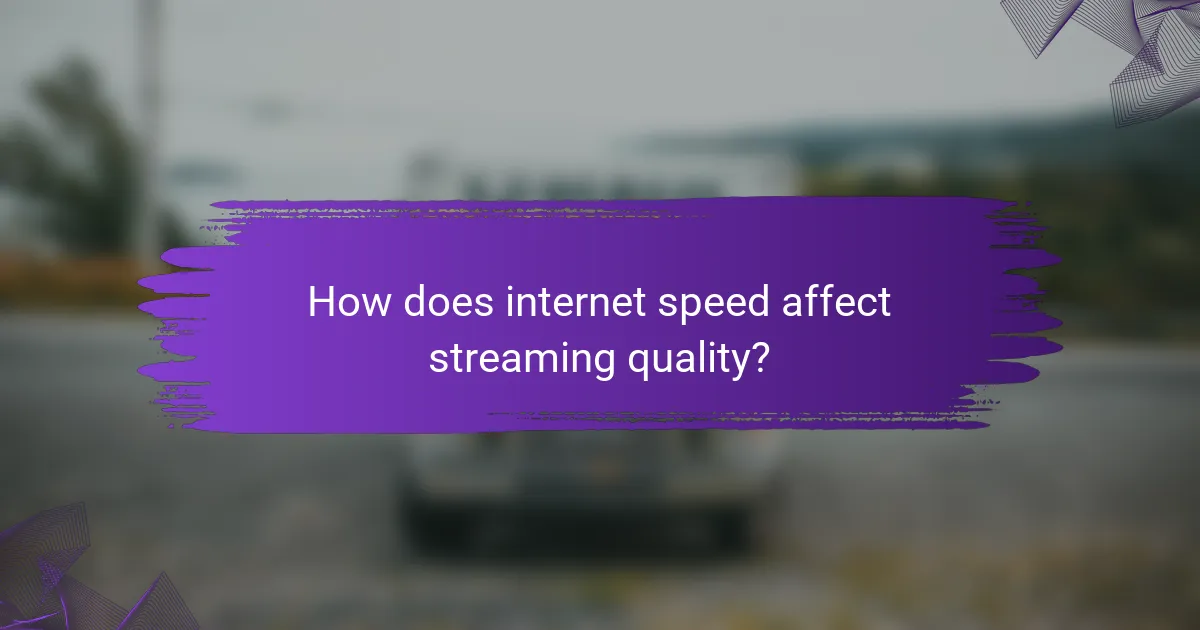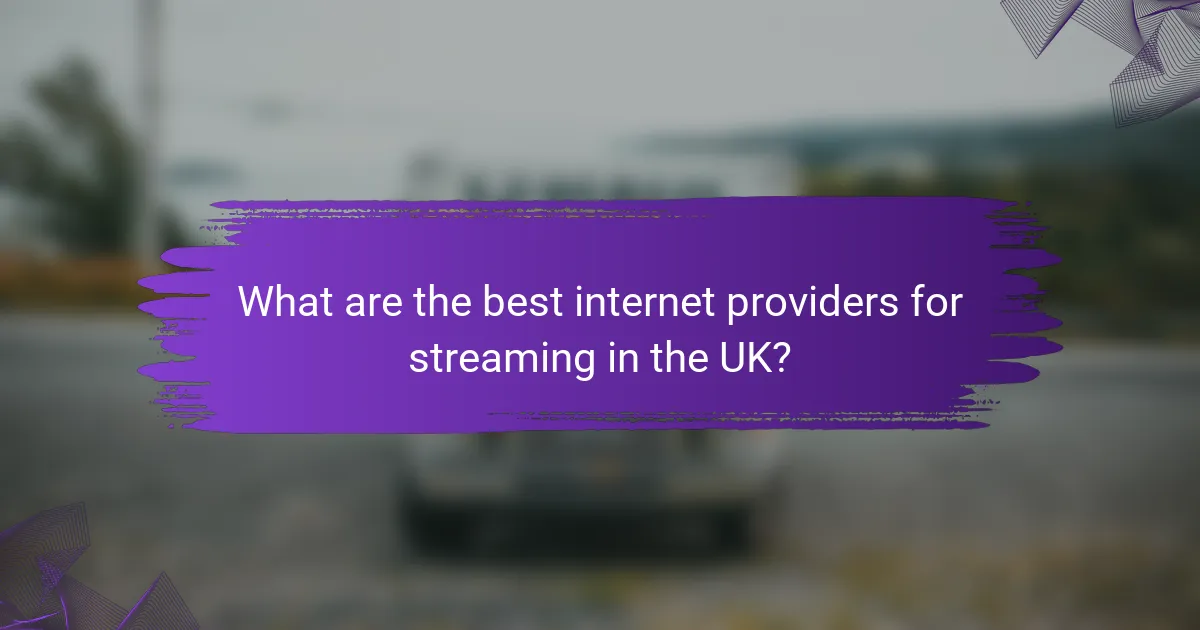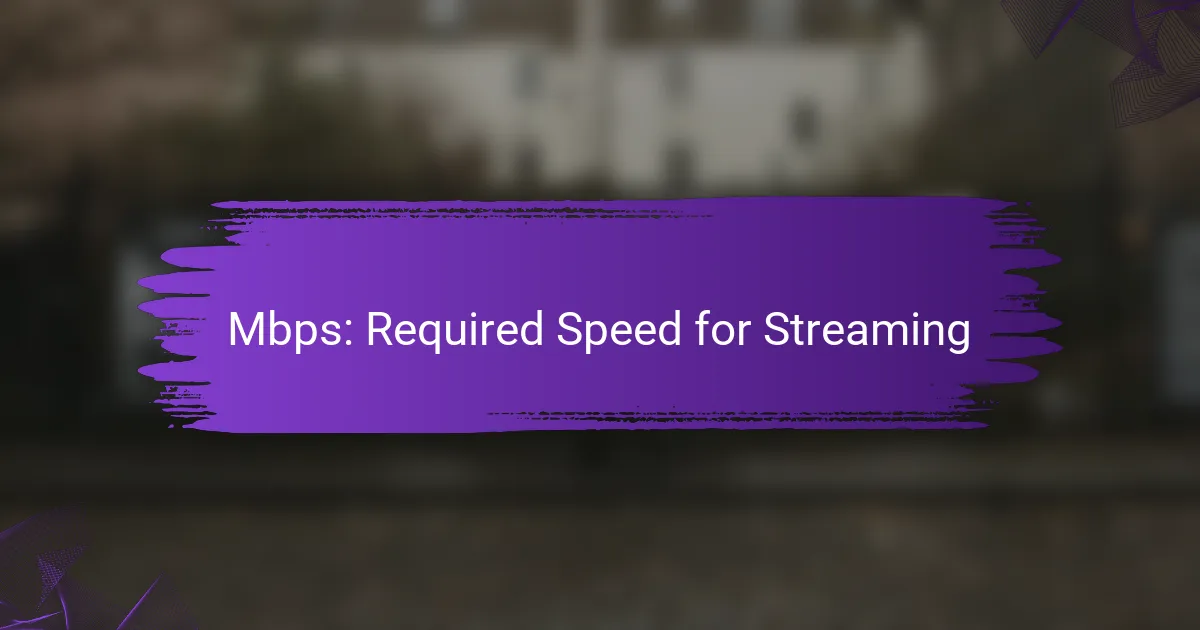When it comes to streaming, the required Mbps varies significantly based on the content quality. For standard definition, a minimum of 3 Mbps is necessary, while high definition demands 5 to 8 Mbps, and 4K streaming ideally requires 25 Mbps or more. Understanding these speed requirements is essential for a seamless viewing experience, as higher speeds minimize buffering and enhance visual quality.

What Mbps speed is required for streaming in the UK?
In the UK, the Mbps speed required for streaming varies based on the quality of the content. For standard definition, a minimum of around 3 Mbps is needed, while high definition typically requires at least 5 to 8 Mbps. For the best experience in 4K streaming, speeds of 25 Mbps or higher are recommended.
Minimum speed for standard definition streaming
The minimum speed for standard definition (SD) streaming is approximately 3 Mbps. This speed allows for a smooth viewing experience without buffering interruptions. Many popular streaming services recommend this speed as a baseline for SD content.
Keep in mind that multiple users on the same network can affect available bandwidth. If several devices are streaming or using the internet simultaneously, consider increasing your speed to avoid issues.
Recommended speed for high definition streaming
For high definition (HD) streaming, a recommended speed of 5 to 8 Mbps is ideal. This range ensures that you can enjoy clear visuals without lag. Most streaming platforms, such as Netflix and Amazon Prime, suggest this speed for optimal HD viewing.
When streaming in HD, be aware that fluctuations in speed can occur due to network congestion or distance from the router. If you experience buffering, it may be beneficial to upgrade your internet plan or connect via Ethernet for a more stable connection.
Optimal speed for 4K streaming
The optimal speed for 4K streaming is generally 25 Mbps or higher. This speed is necessary to handle the large amount of data that 4K content requires, ensuring a seamless viewing experience. Many streaming services explicitly recommend this speed for 4K content.
To achieve the best results when streaming in 4K, consider using a wired connection and ensuring your router supports the necessary bandwidth. Additionally, check if your internet service provider offers plans that meet these requirements, especially if you frequently stream high-resolution content.

How does internet speed affect streaming quality?
Internet speed significantly impacts streaming quality, determining how smoothly content plays without interruptions. Higher speeds reduce buffering and improve resolution, while lower speeds can lead to delays and degraded visual experiences.
Impact of bandwidth on buffering
Bandwidth refers to the amount of data that can be transmitted over your internet connection at one time. Insufficient bandwidth can cause buffering, where the video pauses to load more data. For smooth streaming, a minimum of 3-5 Mbps is typically recommended for standard definition, while 25 Mbps or more is ideal for high definition.
To avoid buffering, consider the number of devices using the internet simultaneously, as each device consumes bandwidth. If multiple users are streaming or downloading large files at the same time, you may need a higher bandwidth plan.
Effects of latency on streaming
Latency is the time it takes for data to travel from your device to the server and back. High latency can lead to delays in video playback, making it frustrating for viewers. Ideally, latency should be low, typically under 50 milliseconds, for a seamless streaming experience.
To minimize latency, use a wired connection instead of Wi-Fi when possible, as wired connections generally offer lower latency. Additionally, choosing a streaming service with servers closer to your location can help reduce latency and improve overall streaming quality.

What factors influence required Mbps for streaming?
The required Mbps for streaming is influenced by various factors, including the number of devices connected to the network and the type of streaming service being used. Understanding these elements can help ensure a smooth streaming experience without interruptions.
Number of devices connected
The more devices connected to your network, the higher the required Mbps for streaming. Each device consumes bandwidth, which can lead to slower speeds if the total available bandwidth is insufficient. For example, streaming on one device may require around 5-25 Mbps, while multiple devices can multiply that need significantly.
To optimize your streaming experience, consider limiting the number of devices actively using the internet during peak streaming times. If you notice buffering, it may be helpful to disconnect less critical devices temporarily.
Type of streaming service used
Different streaming services have varying bandwidth requirements based on the quality of the content they deliver. For instance, standard definition (SD) streaming typically requires about 3-4 Mbps, while high definition (HD) can demand 5-10 Mbps, and ultra-high definition (4K) may need 25 Mbps or more.
When choosing a streaming service, check their recommended speeds for optimal performance. Some platforms may also allow you to adjust the streaming quality, which can help manage bandwidth usage if you have multiple users or devices on the same network.

How to test your internet speed for streaming?
To test your internet speed for streaming, use an online speed test tool that measures your download and upload speeds. This will help you determine if your connection can handle the streaming quality you desire.
Using online speed test tools
Online speed test tools are user-friendly and provide immediate results. Popular options include Speedtest by Ookla, Fast.com, and Google’s speed test. Simply visit the website, click the start button, and wait for the test to complete.
For accurate results, ensure no other devices are using the internet during the test. Ideally, connect your device directly to the router via Ethernet for the best measurement, as Wi-Fi can introduce variability.
Interpreting speed test results
When interpreting speed test results, focus on both download and upload speeds. For smooth streaming, a download speed of at least 5 Mbps is generally recommended for standard definition, while 25 Mbps or higher is ideal for high definition.
Additionally, consider latency, measured in milliseconds (ms). Lower latency (under 30 ms) is preferable for real-time streaming, while higher latency can result in buffering and delays. Always compare your results to the requirements of the streaming service you plan to use.

What are the best internet providers for streaming in the UK?
The best internet providers for streaming in the UK typically offer high-speed connections with low latency, ensuring a smooth viewing experience. Key players include BT, Virgin Media, and Sky, each providing various packages tailored for streaming needs.
Comparison of major UK ISPs
When comparing major UK ISPs for streaming, consider factors like speed, reliability, and customer service. BT offers fiber optic plans with speeds up to 900 Mbps, while Virgin Media provides packages that can reach similar speeds. Sky, on the other hand, focuses on bundled services that include streaming subscriptions.
Pricing varies, with basic packages starting around £25 per month and premium options exceeding £50. It’s essential to assess the total cost, including any installation fees and equipment rental charges.
Customer reviews on streaming performance
Customer reviews often highlight the importance of consistent speeds and minimal buffering. Many users report that Virgin Media excels in speed but may experience occasional service interruptions. BT is frequently praised for its customer support and overall reliability.
Sky users appreciate the integration of streaming services but sometimes note slower speeds during peak hours. Checking recent reviews can provide insights into current performance trends and help you make an informed decision.

What are common issues with streaming speeds?
Common issues with streaming speeds include buffering, low video quality, and interruptions. These problems often arise from inadequate internet bandwidth, network congestion, or hardware limitations.
Causes of slow streaming
Slow streaming can be caused by several factors, including insufficient internet speed, which is typically below 5 Mbps for standard definition and 25 Mbps for high definition. Network congestion during peak usage times can also lead to slower speeds, as multiple users share the same bandwidth.
Additionally, outdated hardware such as routers or streaming devices may struggle to handle modern streaming requirements. Poor Wi-Fi signal strength due to distance from the router or physical obstructions can further degrade performance.
Solutions for improving streaming speed
To enhance streaming speed, consider upgrading your internet plan to ensure you have sufficient bandwidth for your needs. For high-definition streaming, aim for speeds of at least 25 Mbps, while 50 Mbps or more is ideal for multiple users or devices.
Improving your Wi-Fi setup can also help. Position your router centrally in your home, reduce interference from other electronic devices, and consider using a wired Ethernet connection for devices that require stable streaming. Regularly updating your router’s firmware can also optimize performance.
Lastly, limit the number of devices connected to your network while streaming to minimize congestion. Disconnecting unused devices can significantly improve your streaming experience.

How to optimize your home network for streaming?
To optimize your home network for streaming, focus on improving your router’s placement and settings, as well as considering the type of connection you use. These adjustments can significantly enhance your streaming experience by reducing buffering and improving video quality.
Router placement and settings
Proper router placement is crucial for maximizing your network’s performance. Position your router in a central location, elevated and away from obstructions like walls or furniture, to ensure even coverage throughout your home.
Additionally, adjust your router settings for optimal performance. Use the 5 GHz band for streaming when possible, as it offers faster speeds and less interference compared to the 2.4 GHz band. Regularly updating your router’s firmware can also enhance security and performance.
Using wired connections vs. Wi-Fi
Wired connections generally provide a more stable and faster internet experience compared to Wi-Fi. If possible, connect streaming devices directly to your router using Ethernet cables, especially for high-definition or 4K streaming.
However, if you must use Wi-Fi, ensure your devices are close to the router and consider using a Wi-Fi extender if you experience weak signals. Keep in mind that network congestion can affect performance, so limit the number of devices connected during streaming sessions.
